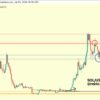
Bitcoin (BTC) has recently found itself at the center of significant speculative attention. Recent analysis by leading crypto analysts including Jelle, suggest that Bitcoin could be forming an inverse head and shoulders pattern, a development that has historically been associated with potential bullish market trends.
Bitcoin (BTC) has recently found itself at the center of significant speculative attention. Recent analysis by leading crypto analysts including Jelle, suggest that Bitcoin could be forming an inverse head and shoulders pattern, a development that has historically been associated with potential bullish market trends.
The inverse head and shoulders pattern is a chart formation that predicts the reversal of a current downtrend into a new uptrend. It is characterized by three valleys, the middle one (the head) being the deepest and the two outer ones (the shoulders) being shallower.
According to Jelle, Bitcoin may be in the cards to form this pattern. This technical analysis points towards a possible rally for Bitcoin if it manages to break through the neckline of this pattern and convert a critical resistance level into support. Such a move could catapult the price towards its previous all-time high levels, thus restoring market confidence and investor interest.
Current market sentiment and challenges
Despite optimistic technical forecasts, the current performance of the Bitcoin market paints a contrasting picture. Currently, Bitcoin is experiencing a recession, trading at $64,844, which represents a decrease of 2.82% in the last 24 hours. Additionally, Bitcoin trading volume has seen a significant reduction of 29.91% and currently stands at $40.31 billion.
This slowdown is part of a broader market correction, affecting several cryptocurrencies and stemming from multiple factors, including regulatory news, macroeconomic conditions, and changes in investor sentiment. Amid these fluctuations, the crypto community is eagerly awaiting the next Bitcoin halving event, scheduled for April.
Halving events are important to Bitcoin’s economic model as they reduce the reward for mining new blocks, effectively halving the supply of new coins entering the market. Historically, these events have caused prices to rise due to reduced supply and increased scarcity of Bitcoin.
Analysts predict that the current consolidation phase could continue until the halving before witnessing a possible breakout. The anticipation is based on historical patterns where halvings have been followed by bulls. Market behavioralthough it is important to note that past performance is not always indicative of future results.























